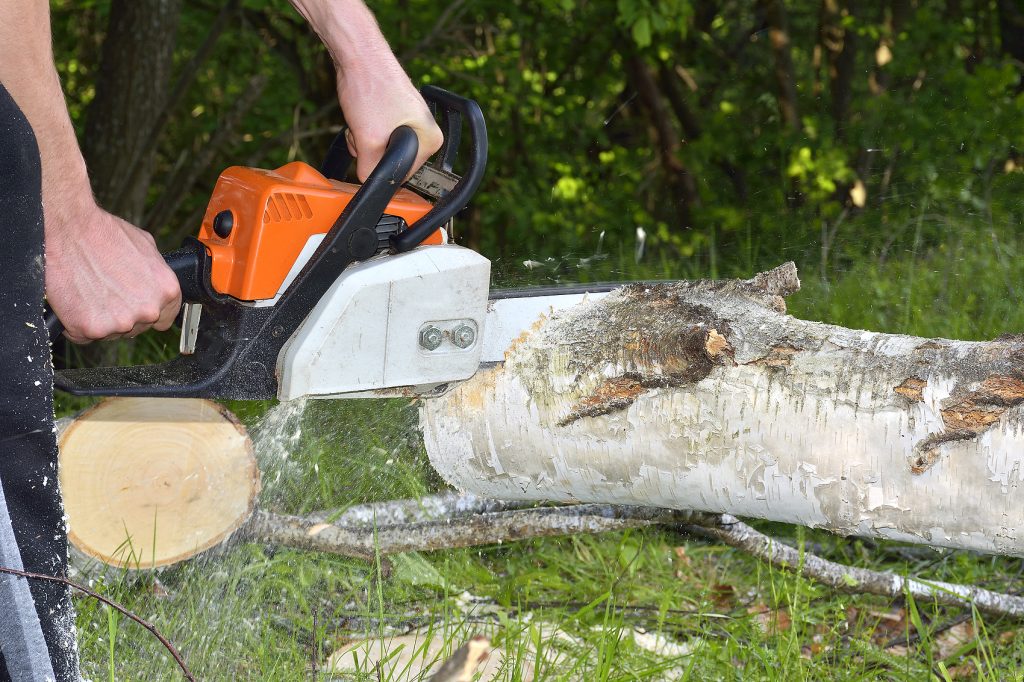Chainsaws are incredibly useful tools that save time and effort when cutting through large trees and logs. What might take hours with an axe and handsaw can be done in minutes with a chainsaw. But, with that convenience comes risk. Accidents can happen easily if proper safety measures aren’t followed. Here’s a simple guide to help you stay safe while using a chainsaw.
Choosing the Right Chainsaw
The Right Tool
Modern chainsaws are much more ergonomic and easier to handle than older models, with less vibration to reduce fatigue. They also come with several built-in safety features, such as:
- A chain catcher to prevent a detached chain from causing harm.
- A chain stop that activates if the saw kicks back.
- A throttle lock to stop accidental acceleration.
- A hand guard to protect your hand from a broken chain.
- An easily accessible stop switch to quickly turn off the chainsaw.
The Right Size
If you’re new to using a chainsaw, it’s best to start with a smaller, lighter model. Smaller chainsaws (14 or 16 inches) are easier to maneuver and put less strain on your body. Larger saws (18 or 20 inches) are more suited for big jobs like cutting through large logs.
The Right Condition
Make sure your chainsaw is in good working order. The chain should be sharp, and the oil tank should be full to keep it lubricated. Adjust the chain tension so it’s neither too loose nor too tight. A loose chain could come off, while a tight one could wear out the bar faster or fail to cut.

Protective Gear
Clothing
Even if it’s hot out, always wear long pants and a long-sleeved shirt. This helps protect you from flying debris like sticks and bark. If you’re working on a large project, consider wearing chainsaw chaps, which provide extra protection.
Work Boots
Steel-toe boots are a must. They protect your feet in case a log rolls or falls unexpectedly. Though you should always keep your feet away from the saw, steel-toed boots offer added protection if an accident occurs.
Heavy-Duty Gloves
Wear thick, protective gloves. Leather gloves are a good choice, but you can also find gloves designed specifically for chainsaw use. These often have extra layers of protection on the parts of the glove closest to the chain.
Head, Face, and Ears
Chainsaws are loud, so always wear ear protection to prevent hearing damage. Safety glasses or goggles are essential to protect your eyes from flying debris. A forestry helmet, which includes earmuffs and a face shield, is a great option for added protection.
Risk Factors to Consider
Before you start using a chainsaw, consider these factors to minimize safety risks.
Lighting
It’s not safe to use a chainsaw at dusk or in low light. You might miss obstacles or hazards like branches that can snap back at you. Always work in good lighting so you can clearly see what you’re doing.
Weather
Avoid using a chainsaw in bad weather. Rain, ice, and strong winds can make the ground slippery and increase the risk of accidents. Wind, in particular, can be dangerous when trying to cut down a tree.
Surroundings
Make sure no one is nearby when you’re using a chainsaw. People, pets, or even vehicles could be in harm’s way if something goes wrong. Also, clear the area of debris or obstacles that could trip you or block your escape route in case of an emergency.
Hazards
One of the biggest risks with chainsaws is kickback. This happens when the tip of the chainsaw’s guide bar strikes an object like a branch or stump. The force of the chain’s rotation can cause the saw to kick back toward you. Always inspect the area for hidden hazards like nails or metal fragments that could damage the chain or cause a dangerous kickback.
Stamina
Chainsaw work can be physically demanding, so take breaks when needed. Stay hydrated and work in the shade to avoid exhaustion. Fatigue can slow your reactions, making accidents more likely.

Tips for Safe Operation
To use your chainsaw safely, follow these tips:
- Stand with your feet apart and your left foot slightly ahead of your right for better balance.
- Bend your knees while cutting to avoid back strain.
- Keep a firm grip on the chainsaw with your hands fully wrapped around the handles.
- Hold the chainsaw close to your body to maintain control and prevent strain.
- Always cut with the bottom of the chain, never the top.
- Don’t raise the chainsaw above shoulder height while cutting.
- If you need to move, turn off the engine or engage the chain brake before walking with the saw.
- Stay aware of your surroundings and have an escape route in mind in case of unexpected hazards.
By using the right equipment, wearing the proper gear, and following safe practices, you can significantly reduce the risk of injury and make your chainsaw work safer and more efficient.












